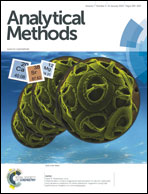Analysis of steroid hormones in human saliva by matrix-assisted laser desorption/ionization mass spectrometry†
Abstract
This work describes a simple and rapid method for the quantitative analysis of four steroid hormones, including testosterone, progesterone, hydrocortisone and cortisone in human saliva samples by matrix-assisted laser desorption/ionization (MALDI) mass spectrometry using nanomaterials as the matrix. The optimal pretreatment processes of saliva samples as well as MALDI conditions for efficient desorption/ionization of these steroid hormones are systematically explored. Parameters, including the concentration and pH level of ammonium citrate buffer, the nature and concentration of the MALDI matrix, laser energy, and the sample extraction method, were systematically investigated in this study. The limits of detection at a signal to noise ratio of 3 for testosterone, progesterone, hydrocortisone and cortisone provided by the proposed approach are 6.0, 6.0, 6.0, and 3.0 μM, respectively, with satisfactory quantitative linearity (R2 > 0.985) and recovery (89.3–111.2%) for the four analytes. Our technique provides the advantages of sensitivity, repeatability, speed, and simplicity for the quantitation of the four steroid hormones in saliva samples. This method holds great potential for high-throughput biological screening and disease detection.



 Please wait while we load your content...
Please wait while we load your content...